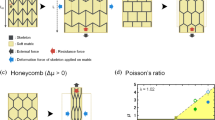Abstract
The final aim of the two parts of this study is to quantify the gain in strength of a layered heterogeneous structure caused by the elastic contrast between the layers, especially if no crack deflection is observed at the interface. In part I, the analysis focus on an example, the 3 point-bending of a bimaterial made of a compliant and a stiff layer; whereas part II is dedicated to the 3-point bending of a homogeneous beam embedding a thin stiff film. Baptized “step-over” and “jump-through”, two original mechanisms of crack crossing the interface are proposed herein. They rely on a coupled criterion involving both energy requirement and stress condition. It is established from asymptotic expansions and the theory of singularities. This criterion is able to respond to the paradox posed by the traditional tools of brittle fracture mechanics which might carelessly conclude to a quasi infinite strength enhancement. The subtitle of this first part might be: can a crack pass through an interface?
Similar content being viewed by others
References
Bermejo R, Danzer R (2010) High failure resistance layered ceramics using crack bifurcation interface delamination as reinforcement mechanisms. Eng Fract Mech 77: 2126–2135
Chai H (2011) Channel cracking in inelastic film/substrate system. Int J Solids Struct 48: 1092–1100
Chai H, Ravichandran G (2007) Transverse fracture in multilayers from tension and line-wedge indentation. Int J Fract 145: 299–312
Clegg WJ (1992) The fabrication and failure of laminar ceramic composites. Acta Metall 40: 3085–3093
Clegg WJ, Blanks KS, Davis JB, Lanckmans F (1997) Porous interfaces as crack deflecting interlayers in ceramic laminates. Key Eng Mater 132–136,1866–1869
Cook J, Gordon JE (1964) A mechanism for the control of crack propagation in all brittle systems. Proc Roy Soc 282: 508–520
Folsom CA, Zok F.W, Lange FF (1994) Flexural properties of brittle multilayers: II, experiments. J Am Ceram Soc 77: 2081–2087
Freund LB (1990) Dynamic fracture mechanics. Cambridge University Press, Cambridge
Gao H, Rice JR (1989) A first-order perturbation analysis of crack trapping by arrays of obstacles. J Appl Mech 56: 828–836
He MY, Hutchinson JW (1989) Crack deflection at an interface between dissimilar elastic materials. Int J Solids Struct 25: 1053–1067
Helgeson DE, Aydin A (1991) Caracteristics of joint propagation across layer interfaces in sedimentary rocks. J Struct Geol 13(8): 897–911
Katti KS., Katti DR (2006) Why is nacre so tough and strong?. Mater Sci Eng C 26: 1317–1324
Lee JJW, Lloyd IK, Chai H, Jung YG, Lawn BR (2007) Arrest, deflection, penetration and reinitiation of cracks in brittle layers across adhesive interlayers. Acta Mater 55: 5859–5866
Leguillon D (2002) Strength or toughness ? A criterion for crack onset at a notch. Eur J Mech–A/Solids 21: 61–72
Leguillon D (2011) Determination of the length of a short crack at a v-notch from a full field measurement. Int J Solids Struct 48: 884–892
Leguillon D, Lacroix C, Martin E (2000) Interface debonding ahead of a primary crack. J Mech Phys Solids 48: 2137–2161
Leguillon D, Lacroix C, Martin E (2000) Matrix crack deflection at an interface between a stiff matrix and a soft inclusion. CR Acad Sci Paris 328, série IIb, 2000, 19–24
Leguillon D, Martin E (2012a) Crack nucleation at stress concentration points in composite materials—application to the crack deflection by an interface. In: Mantic V (ed) Mathematical methods and models in composites, computational and experimental methods in structures. Imperial College Press, London, to appear
Leguillon D, Martin E (2012b) The strengthening effect caused by an elastic contrast—part II: stratification by a thin stiff layer. in preparation
Leguillon D, Sanchez-Palencia E (1987) Computation of singular solutions in elliptic problems and elasticity. Wiley, New York
Leguillon D, Sanchez-Palencia E (1992) Fracture in heterogeneous materials, weak and strong singularities. In: Proceedings of the European conference on new advances in computational structural mechanics, Ladevèze P., Zienkiewicz 0. eds., Elsevier, Amsterdam, 229–236
Lugovy M, Slyunyayev V, Orlovskaya N, Blugan G, Kuebler J, Lewis M (2005) Apparent fracture toughness of Si 3 N 4-based laminates with residual compressive or tensile stresses in surface layers. Acta Mater 53: 289–296
Nahlik L, Sestakova L, Hutar P, Bermejo R (2010) Prediction of crack propagation in layered ceramics with strong interfaces. Eng Fract Mech 77: 2192–2199
Pageau S, Gadi K, Biggers S, Joseph P (1996) Standardized complex and logarithmic eigensolutions for n-material wedges and junctions. Int J Fract 77: 51–76
Shaw MC, Marshall DB, Dadkhah MS, Evans AG (1993) Cracking and damage mechanisms in ceramic/metal multilayers. Acta Metall Mater 41(11): 331–3322
Author information
Authors and Affiliations
Corresponding author
Rights and permissions
About this article
Cite this article
Leguillon, D., Martin, E. The strengthening effect caused by an elastic contrast—part I: the bimaterial case. Int J Fract 179, 157–167 (2013). https://doi.org/10.1007/s10704-012-9787-y
Received:
Accepted:
Published:
Issue Date:
DOI: https://doi.org/10.1007/s10704-012-9787-y




